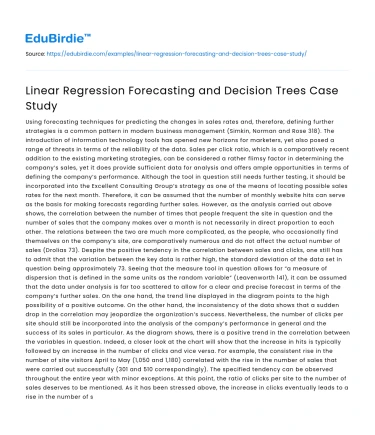Using forecasting techniques for predicting the changes in sales rates and, therefore, defining further strategies is a common pattern in modern business management (Simkin, Norman and Rose 318). The introduction of information technology tools has opened new horizons for marketers, yet also posed a range of threats in terms of the reliability of the data. Sales per click ratio, which is a comparatively recent addition to the existing marketing strategies, can be considered a rather flimsy factor in determining the company’s sales, yet it does provide sufficient data for analysis and offers ample opportunities in terms of defining the company’s performance. Although the tool in question still needs further testing, it should be incorporated into the Excellent Consulting Group’s strategy as one of the means of locating possible sales rates for the next month.
Therefore, it can be assumed that the number of monthly website hits can serve as the basis for making forecasts regarding further sales. However, as the analysis carried out above shows, the correlation between the number of times that people frequent the site in question and the number of sales that the company makes over a month is not necessarily in direct proportion to each other. The relations between the two are much more complicated, as the people, who occasionally find themselves on the company’s site, are comparatively numerous and do not affect the actual number of sales (Drolias 73).
Save your time!
We can take care of your essay
- Proper editing and formatting
- Free revision, title page, and bibliography
- Flexible prices and money-back guarantee
Despite the positive tendency in the correlation between sales and clicks, one still has to admit that the variation between the key data is rather high, the standard deviation of the data set in question being approximately 73. Seeing that the measure tool in question allows for “a measure of dispersion that is defined in the same units as the random variable” (Leavenworth 141), it can be assumed that the data under analysis is far too scattered to allow for a clear and precise forecast in terms of the company’s further sales. On the one hand, the trend line displayed in the diagram points to the high possibility of a positive outcome. On the other hand, the inconsistency of the data shows that a sudden drop in the correlation may jeopardize the organization’s success.
Nevertheless, the number of clicks per site should still be incorporated into the analysis of the company’s performance in general and the success of its sales in particular. As the diagram shows, there is a positive trend in the correlation between the variables in question. Indeed, a closer look at the chart will show that the increase in hits is typically followed by an increase in the number of clicks and vice versa. For example, the consistent rise in the number of site visitors April to May (1,050 and 1,180) correlated with the rise in the number of sales that were carried out successfully (301 and 510 correspondingly). The specified tendency can be observed throughout the entire year with minor exceptions.
At this point, the ratio of clicks per site to the number of sales deserves to be mentioned. As it has been stressed above, the increase in clicks eventually leads to a rise in the number of sales; however, the extent, to which sales increase, is not consistent. According to the chart, the ratios observed from January to March varied from 1,917808219 to 3,488372093. In other words, assuming that the connection between the number of sales and the number of clicks per site is obvious would be quite hasty.
Nevertheless, the standard deviation of the specified ratio is rather low, which allows suggesting that the ratio of clicks to sales should still be trusted as a means of carrying out quite an accurate forecast of future sales (McCallum 6). Particularly, the standard deviation of the above-mentioned ratio makes approximately 0.45, which means that the data in question can be viewed as trustworthy.
To determine the efficacy of the tool in question, one should forecast the sales that the company is likely to make in the next three months. Using the formula that was generated with the help of a scatter plot, one will conclude that the organization is likely to experience a slight increase in its monthly income (Stokes 237). Specifically, the sales forecast will allow estimating the sales for three months, i.e., February, March, and April. Particularly, the formula shows that the sales rates are going to reach approximately 504, whereas a slight drop is expected in March (485). In April, however, the rates of the product sales are going to rise slightly, though failing to reach the February level (482). Though the specified results do not quite coincide with the actual ones, they still are rather close to the company’s data. Hence, it can be assumed that the tool in question can and should be used as one of the means for determining the company’s sales.
Although the tendency for the sales in the target company to rise along with the amount of clicks per month is rather weak, it is still positive, which allows suggesting that it should be used as the basis for making prognoses for future sales. One must bear in mind, though, that the current trend is rather weak and, therefore, needs substantial support, i.e., the risk management strategy (Hull 817) that can ensure that the organization will not go bankrupt in case of a failure.






 Stuck on your essay?
Stuck on your essay?

